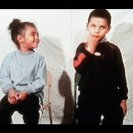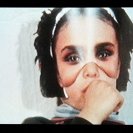Partly fictitious and partly autobiographical, Destiny Deacon’s world is populated by a cast of dolls, family and friends who enact ‘soap opera’ vignettes (1). She dramatises human comedies and tragedies within invented and fabricated dioramas, her entourage accompanied by masks, props and costumes revealing human foibles. Characters seem to be acting up and acting out.
The narrative series Forced into images (2001) derives from an unpublished letter by Alice Walker to a social worker friend researching racial stereotypes: ’I see our brothers and sisters, mothers and fathers, captured and forced into images, doing hard time for all of us’.(2) In the Super 8 component of this series – made with long-time collaborator Virginia Fraser and later transferred to digital video – two children sit on chairs before the camera. The characters are Deacon’s niece and nephew who came over to her sister’s home when they were about four years old. Deacon hoped they would dress up for the ’occasion‘– making a video – but they arrived in casual attire. The footage is silent, but the exchange between these young relatives recall the ways that people make assumptions about colour and identity – the play further articulated by the various masks that obscure their faces. Deacon’s word play is an astute game and a scathing indictment on racial stereotypes.
Asked about the different skin colours of the two subjects and how writers have drawn inferences about intent and meaning, Deacon responded: ‘I never saw skin colour as a factor. I was pleased that one was a boy and one was a girl, because it’s good to have a mixture, but they were my nephew and niece, and the most important thing about them was that they were four-year-olds and uncontrollable, and fitted into the idea of being forced into images. It amazes me that people see them as black and white. That’s just part of being Aborigine. We come in different shades. He’s black as well. It’s not an issue. (3)
1) Not only do Deacon’s dolls act out scenes of oppression but her titles, sometimes inspired from songs, ’pack a punch‘. (For instance, the survey exhibition title Walk & don’t look blak is from a Temptations song covered by the Rolling Stones. ’Back‘ has been cleverly replaced with ’blak‘ – a term coined by Deacon herself in 1991 with the work Blak lik me)
2) Alice Walker, from a 1981 unpublished letter to Jan Faulkner, an African-American psychiatric social worker and friend of Walker’s who amassed a major collection of material featuring racist stereotypes. Printed in Ethnic Notions: Black Images in the White Mind, the catalogue for two exhibitions of the collection, Berkeley Art Center, Berkeley, first published 1982, updated and revised version 2000, pp 11-12
3) Interview with Virginia Fraser, p 109ff











